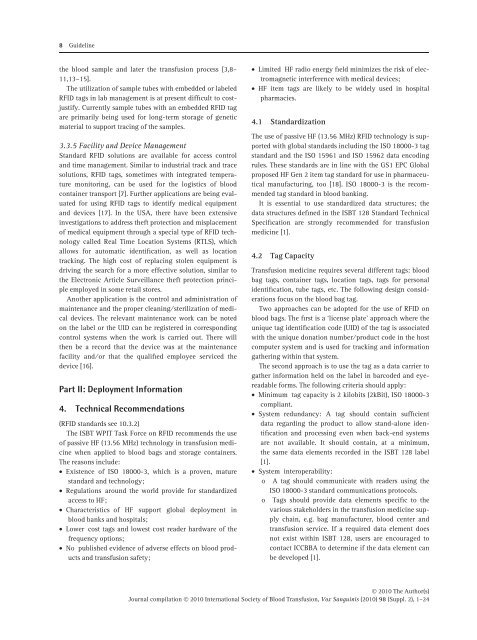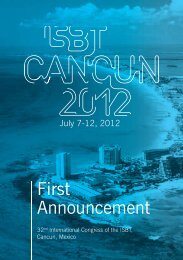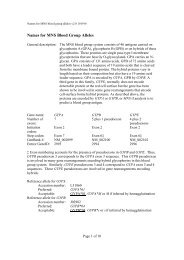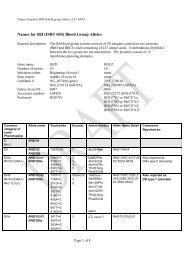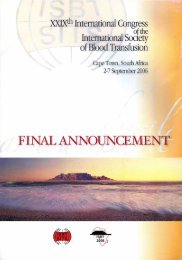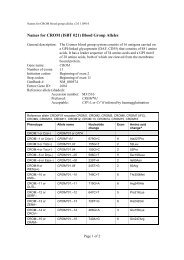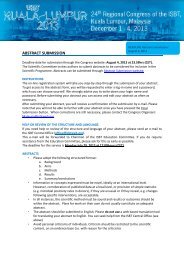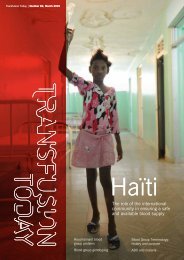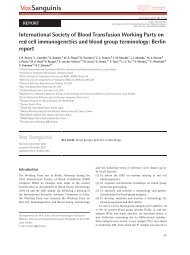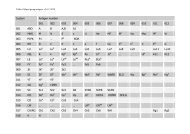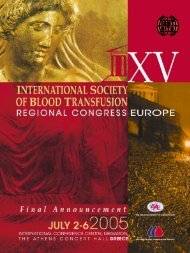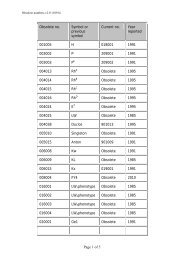8 Guidel<strong>in</strong>e<strong>the</strong> blood sample and later <strong>the</strong> transfusion process [3,8–11,13–15].The utilization <strong>of</strong> sample tubes with embedded or labeled<strong>RFID</strong> tags <strong>in</strong> lab management is at present difficult to costjustify.Currently sample tubes with an embedded <strong>RFID</strong> tagare primarily be<strong>in</strong>g used <strong>for</strong> long-term storage <strong>of</strong> geneticmaterial to support trac<strong>in</strong>g <strong>of</strong> <strong>the</strong> samples.3.3.5 Facility and Device ManagementStandard <strong>RFID</strong> solutions are available <strong>for</strong> access controland time management. Similar to <strong>in</strong>dustrial track and tracesolutions, <strong>RFID</strong> tags, sometimes with <strong>in</strong>tegrated temperaturemonitor<strong>in</strong>g, can be used <strong>for</strong> <strong>the</strong> logistics <strong>of</strong> bloodconta<strong>in</strong>er transport [7]. Fur<strong>the</strong>r applications are be<strong>in</strong>g evaluated<strong>for</strong> us<strong>in</strong>g <strong>RFID</strong> tags to identify medical equipmentand devices [17]. In <strong>the</strong> USA, <strong>the</strong>re have been extensive<strong>in</strong>vestigations to address <strong>the</strong>ft protection and misplacement<strong>of</strong> medical equipment through a special type <strong>of</strong> <strong>RFID</strong> technologycalled Real Time Location Systems (RTLS), whichallows <strong>for</strong> automatic identification, as well as locationtrack<strong>in</strong>g. The high cost <strong>of</strong> replac<strong>in</strong>g stolen equipment isdriv<strong>in</strong>g <strong>the</strong> search <strong>for</strong> a more effective solution, similar to<strong>the</strong> Electronic Article Surveillance <strong>the</strong>ft protection pr<strong>in</strong>cipleemployed <strong>in</strong> some retail stores.Ano<strong>the</strong>r application is <strong>the</strong> control and adm<strong>in</strong>istration <strong>of</strong>ma<strong>in</strong>tenance and <strong>the</strong> proper clean<strong>in</strong>g ⁄ sterilization <strong>of</strong> medicaldevices. The relevant ma<strong>in</strong>tenance work can be notedon <strong>the</strong> label or <strong>the</strong> UID can be registered <strong>in</strong> correspond<strong>in</strong>gcontrol systems when <strong>the</strong> work is carried out. There will<strong>the</strong>n be a record that <strong>the</strong> device was at <strong>the</strong> ma<strong>in</strong>tenancefacility and ⁄ or that <strong>the</strong> qualified employee serviced <strong>the</strong>device [16].Part II: Deployment In<strong>for</strong>mation4. Technical Recommendations(<strong>RFID</strong> standards see 10.3.2)The ISBT WPIT Task Force on <strong>RFID</strong> recommends <strong>the</strong> use<strong>of</strong> passive HF (13.56 MHz) technology <strong>in</strong> transfusion medic<strong>in</strong>ewhen applied to blood bags and storage conta<strong>in</strong>ers.The reasons <strong>in</strong>clude:• Existence <strong>of</strong> ISO 18000-3, which is a proven, maturestandard and technology;• Regulations around <strong>the</strong> world provide <strong>for</strong> standardizedaccess to HF;• Characteristics <strong>of</strong> HF support global deployment <strong>in</strong>blood banks and hospitals;• Lower cost tags and lowest cost reader hardware <strong>of</strong> <strong>the</strong>frequency options;• No published evidence <strong>of</strong> adverse effects on blood productsand transfusion safety;• Limited HF radio energy field m<strong>in</strong>imizes <strong>the</strong> risk <strong>of</strong> electromagnetic<strong>in</strong>terference with medical devices;• HF item tags are likely to be widely used <strong>in</strong> hospitalpharmacies.4.1 StandardizationThe use <strong>of</strong> passive HF (13.56 MHz) <strong>RFID</strong> technology is supportedwith global standards <strong>in</strong>clud<strong>in</strong>g <strong>the</strong> ISO 18000-3 tagstandard and <strong>the</strong> ISO 15961 and ISO 15962 data encod<strong>in</strong>grules. These standards are <strong>in</strong> l<strong>in</strong>e with <strong>the</strong> GS1 EPC Globalproposed HF Gen 2 item tag standard <strong>for</strong> use <strong>in</strong> pharmaceuticalmanufactur<strong>in</strong>g, too [18]. ISO 18000-3 is <strong>the</strong> recommendedtag standard <strong>in</strong> blood bank<strong>in</strong>g.It is essential to use standardized data structures; <strong>the</strong>data structures def<strong>in</strong>ed <strong>in</strong> <strong>the</strong> ISBT 128 Standard TechnicalSpecification are strongly recommended <strong>for</strong> transfusionmedic<strong>in</strong>e [1].4.2 Tag Capacity<strong>Transfusion</strong> medic<strong>in</strong>e requires several different tags: bloodbag tags, conta<strong>in</strong>er tags, location tags, tags <strong>for</strong> personalidentification, tube tags, etc. The follow<strong>in</strong>g design considerationsfocus on <strong>the</strong> blood bag tag.Two approaches can be adopted <strong>for</strong> <strong>the</strong> use <strong>of</strong> <strong>RFID</strong> onblood bags. The first is a ‘license plate’ approach where <strong>the</strong>unique tag identification code (UID) <strong>of</strong> <strong>the</strong> tag is associatedwith <strong>the</strong> unique donation number ⁄ product code <strong>in</strong> <strong>the</strong> hostcomputer system and is used <strong>for</strong> track<strong>in</strong>g and <strong>in</strong><strong>for</strong>mationga<strong>the</strong>r<strong>in</strong>g with<strong>in</strong> that system.The second approach is to use <strong>the</strong> tag as a data carrier toga<strong>the</strong>r <strong>in</strong><strong>for</strong>mation held on <strong>the</strong> label <strong>in</strong> barcoded and eyereadable<strong>for</strong>ms. The follow<strong>in</strong>g criteria should apply:• M<strong>in</strong>imum tag capacity is 2 kilobits (2kBit), ISO 18000-3compliant.• System redundancy: A tag should conta<strong>in</strong> sufficientdata regard<strong>in</strong>g <strong>the</strong> product to allow stand-alone identificationand process<strong>in</strong>g even when back-end systemsare not available. It should conta<strong>in</strong>, at a m<strong>in</strong>imum,<strong>the</strong> same data elements recorded <strong>in</strong> <strong>the</strong> ISBT 128 label[1].• System <strong>in</strong>teroperability:o A tag should communicate with readers us<strong>in</strong>g <strong>the</strong>ISO 18000-3 standard communications protocols.o Tags should provide data elements specific to <strong>the</strong>various stakeholders <strong>in</strong> <strong>the</strong> transfusion medic<strong>in</strong>e supplycha<strong>in</strong>, e.g. bag manufacturer, blood center andtransfusion service. If a required data element doesnot exist with<strong>in</strong> ISBT 128, users are encouraged tocontact ICCBBA to determ<strong>in</strong>e if <strong>the</strong> data element canbe developed [1].Ó 2010 The Author(s)Journal compilation Ó 2010 International Society <strong>of</strong> Blood <strong>Transfusion</strong>, Vox Sangu<strong>in</strong>is (2010) 98 (Suppl. 2), 1–24
Guidel<strong>in</strong>e 94.3 Tag Functionality and SecurityThe <strong>RFID</strong> tag will carry critical blood product label<strong>in</strong>g<strong>in</strong><strong>for</strong>mation. It is <strong>the</strong>re<strong>for</strong>e essential to ensure <strong>the</strong> securityand <strong>in</strong>tegrity <strong>of</strong> this <strong>in</strong><strong>for</strong>mation through suitable design<strong>of</strong> <strong>the</strong> tag as well as <strong>the</strong> s<strong>of</strong>tware application that willbe handl<strong>in</strong>g <strong>the</strong> data. Key security features are listed asfollows:• Tags will have <strong>the</strong>ir own Application Function Identifier(AFI) as designated by ISO 7816. This AFI <strong>in</strong>dicates that<strong>the</strong> tag conta<strong>in</strong>s data structures assigned by ICCBBA <strong>for</strong>use by <strong>the</strong> blood <strong>in</strong> collection, process<strong>in</strong>g, distributionand transfusion.• The required tag data structures will be identical to thoseused <strong>for</strong> ISBT 128 barcode data [1].• Key data elements on <strong>the</strong> tag will be written and locked<strong>in</strong> pre-def<strong>in</strong>ed memory blocks, thus prevent<strong>in</strong>g updatesto <strong>the</strong>se key data elements (e.g. Donation Number;ABO ⁄ Rh) once <strong>the</strong>y are written.• Commands to deactivate ⁄ destroy damaged tags and tore-associate a new tag with a blood product will bedesigned <strong>in</strong>to <strong>the</strong> tag, readers, and application s<strong>of</strong>tware.• Tags may optionally carry <strong>in</strong>ternal process control<strong>in</strong><strong>for</strong>mation used <strong>in</strong> <strong>the</strong> blood center or transfusion siteprocess<strong>in</strong>g. Data shall be recorded <strong>in</strong> such a manner that<strong>the</strong>re will be no possibility <strong>of</strong> confusion with requiredISBT 128 data structures [1].The application design will provide <strong>the</strong> necessary data<strong>in</strong>tegrity and security checks between <strong>the</strong> Blood EstablishmentComputer System (BECS)-generated barcode and <strong>the</strong><strong>RFID</strong> tag at critical control po<strong>in</strong>ts along <strong>the</strong> supply cha<strong>in</strong>.4.4 Method <strong>of</strong> Tag Attachment<strong>RFID</strong> tags can be attached <strong>in</strong> different ways. <strong>RFID</strong> tags canbe <strong>in</strong>corporated <strong>in</strong>to <strong>the</strong> base label by <strong>the</strong> bag manufactureror <strong>the</strong>y can be affixed on <strong>the</strong> base label by <strong>the</strong> blood center,preferably as part <strong>of</strong> <strong>the</strong> donation identification number(DIN) label. In both cases, <strong>the</strong> tags should be affixed to <strong>the</strong>upper part <strong>of</strong> <strong>the</strong> base label to optimize readability withoutcover<strong>in</strong>g any <strong>of</strong> <strong>the</strong> manufacturer’s data.It is imperative that <strong>the</strong> <strong>RFID</strong> tag is embedded <strong>in</strong>to <strong>the</strong>bag or ‘sandwiched’ <strong>in</strong>to <strong>the</strong> DIN, ra<strong>the</strong>r than be<strong>in</strong>g appliedloosely to <strong>the</strong> blood bag itself. If <strong>the</strong> <strong>RFID</strong> tag is applied by<strong>the</strong> manufacturer <strong>of</strong> <strong>the</strong> blood bags, <strong>the</strong> adhesive should be<strong>the</strong> same as is used <strong>for</strong> <strong>the</strong> base label. The adhesive <strong>in</strong>layused <strong>in</strong> transfusion is safe <strong>for</strong> <strong>the</strong> blood components andwill not <strong>in</strong>terfere with <strong>the</strong> chip. This technique will protect<strong>the</strong> <strong>RFID</strong> tag throughout <strong>the</strong> preparation processes and willpreclude removal <strong>of</strong> <strong>the</strong> tag. If <strong>the</strong> <strong>RFID</strong> tag is appliedby <strong>the</strong> manufacturer, it should withstand sterilizationprocesses (vapor sterilization at more than 120°C, Betasterilization or Ethylene Oxide).The location <strong>of</strong> <strong>the</strong> <strong>RFID</strong> tag is also very important <strong>in</strong>order to avoid damage to <strong>the</strong> antenna. When <strong>the</strong> <strong>RFID</strong> tagis placed under or is <strong>in</strong>tegrated <strong>in</strong> <strong>the</strong> base label <strong>of</strong> anempty bag, <strong>the</strong> operator should take care not to fold <strong>the</strong>antenna dur<strong>in</strong>g <strong>the</strong> centrifugation step.The method <strong>of</strong> adhesion should be resistant to centrifugation(up to 5000 g <strong>for</strong> 22 m<strong>in</strong>utes), preparation processes(separation, filtration, blast and contact freez<strong>in</strong>g) and storage(+22 ± 2°C <strong>for</strong> platelets, +4 ± 2°C <strong>for</strong> red blood cells,down to )40°C <strong>for</strong> plasma).4.5 Data StructureIt has been assumed that <strong>the</strong> <strong>RFID</strong> tag will provide datathroughout <strong>the</strong> lifecycle <strong>of</strong> <strong>the</strong> blood bag. The lifecycle <strong>for</strong>each tag could commence at bag manufacture, cont<strong>in</strong>uethrough donation (but not always - e.g. split packs whichmay be <strong>the</strong> start po<strong>in</strong>t <strong>for</strong> a new tag), through componentproduction, issue to hospital, and f<strong>in</strong>ally transfusion topatient (or discard). In this lifecycle <strong>of</strong> <strong>the</strong> <strong>RFID</strong> tag, multiplecomputer systems at various po<strong>in</strong>ts <strong>in</strong> <strong>the</strong> supply cha<strong>in</strong>are likely to be used to read, write and process <strong>the</strong> <strong>RFID</strong> tagdata.The <strong>RFID</strong> tag can act as an electronic data <strong>in</strong>terchange(EDI) carrier between IT systems, although adequate databackup is required to ensure that critical traceability data isnot lost if <strong>the</strong> tag is damaged or discarded. It will be necessaryto set out <strong>the</strong> data structures and method <strong>of</strong> use so thatdata can be added to <strong>the</strong> tag dur<strong>in</strong>g <strong>the</strong> lifecycle <strong>in</strong> a securemanner - <strong>in</strong> <strong>the</strong> same way currently used <strong>for</strong> labels andbarcodes at different stages <strong>in</strong> <strong>the</strong> process.This guidel<strong>in</strong>e assumes use <strong>of</strong> data elements provided byICCBBA <strong>in</strong> <strong>the</strong> ISBT 128 data structure [1]. There is flexibilitybuilt <strong>in</strong>to <strong>the</strong> data structure to allow <strong>for</strong> <strong>the</strong> use <strong>of</strong>non-standardized data elements outside <strong>the</strong> ISBT 128 datastructure, although without standard def<strong>in</strong>itions such datacould not be globally <strong>in</strong>terpreted. Provision should bema<strong>in</strong>ta<strong>in</strong>ed <strong>for</strong> four stakeholders to encode data on <strong>the</strong> tag:• <strong>RFID</strong> Tag Manufacturer• Blood Bag Manufacturer• Blood Center• Hospital <strong>Transfusion</strong> ServiceEach stakeholder will safeguard <strong>the</strong> <strong>in</strong>tegrity, security,and confidentiality <strong>of</strong> <strong>the</strong> data it writes to <strong>the</strong> tag. Thesystem should be sufficiently flexible to accommodate ahospital that collects its own blood. Position<strong>in</strong>g <strong>of</strong> dataelements may change to optimize <strong>the</strong> read ⁄ write cycle <strong>of</strong><strong>the</strong> tag.The structure must be able to comply with different scenarios.In some countries or regions, <strong>the</strong> stakeholders(Blood Center and Hospital <strong>Transfusion</strong> Service) may be<strong>the</strong> same organization. In some cases, <strong>the</strong> tag may beapplied by <strong>the</strong> blood service where a bag manufacturerÓ 2010 The Author(s)Journal compilation Ó 2010 International Society <strong>of</strong> Blood <strong>Transfusion</strong>, Vox Sangu<strong>in</strong>is (2010) 98 (Suppl. 2), 1–24


